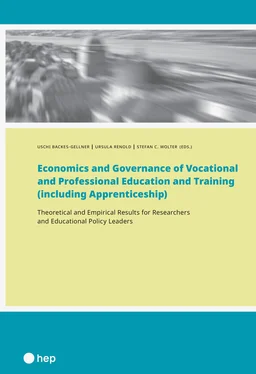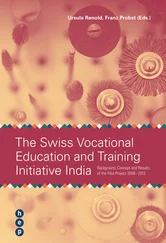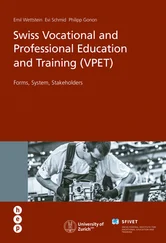Education systems around the world are under constant pressure to adapt. Therefore, complex social processes are set in motion to periodically revise and renew educational programs based on values, norms, and incentive mechanisms. Hence, it is obvious that such programs are socially constructed concepts that fully agree with unobservable meanings and values. Therefore, it will not be possible to find theoretically derived definitions for apprenticeship , VET, and other labels of such programs. “Thus, concepts are cultural constructs that are socially established, valid in limited territories and demonstrate traditions” (Bachleitner et al., 2014, p. 61[3]). If we want to identify the functions lying behind concepts, we have to find a methodology to uncover them.
2.3 Socially Constructed Economy
Economies are social systems (Luhmann, 1995) with specific institutional features and configurations. The employment system is part of the economic system and, through VET programs, is related to education systems. In the following section, we look at the background and underlying theories to determine why social constructs in VET that result from the interaction of actors, institutions, and regulations are so different and try to understand how and why socially constructed meta-institutions control actors’ behavior (Miller, 2019).
One possible reason for differences in the working of VET programs may be the economic policy concept of a country that has an impact on education and employment systems and thus may explain the specific social construction of VET as part of either the education system or, in other contexts, as an active labor-market program (ALMP) and part of the employment system. These in turn are related to historical and contextual factors. The first subsection describes a rival concept that organizes VET programs based on the history of dogma in the political economy, and the second subsection elaborates on a macro-concept regarding variety of capitalism .
2.3.1 Adam Smith and Friedrich List and Rival Concepts
Adam Smith and Friedrich List[4] —two economists —laid the foundations for two different dogmas in the history of political economy. Winch contrasted these two dogmas and summarized their main characteristics: “Smith proposes a market-led low skill model of training, while List proposes a high-skill model sustained by the state and institutions of civil society, such as craft guilds” (Winch, 1998, p. 365) . Both men followed contrasting conceptions of political economy. Therefore, these conceptions are directly relevant for studying VET. In the following section, I summarize four aspects that have had a decisive influence on the development of educational concepts around the world and cite relevant quotes of the two economists.
Smith is regarded as the founder of the concept of the division of labor. Smith distinguished between the invention and implementation of a production process. The former requires an intellectual and the latter a manual effort (Winch, 1998). This attitude can be embodied in educational concepts in that very little education is required for the implementers, and a great deal of education is required for the inventors of new products and processes:
In the progress of the division of labor, the employment of the far greater part of those who live by labor, that is, of the great body of the people, comes to be confined to a few very simple operations; frequently to one or two. But the understandings of the greater part of men are necessarily formed by their ordinary employments. The man whose whole life is spent in performing a few simple operations, of which the effects, too, are perhaps always the same, or very nearly the same, has no occasion to exert his understanding, or to exercise his invention, in finding out expedients for removing difficulties which never occur. He naturally loses, therefore, the habit of such exertion, and generally becomes as stupid and ignorant as it is possible for a human creature to become (Smith, [2012], 1776, p. 777).
Although more than 240 years have passed since the publication of this work, there are still remnants of it found in national education systems, as I will explain in the next section.
Narrow versus Broad Skills Set
List questioned the distinction between productive and unproductive employment, which is central to the Smith model (Winch, 1998). List stressed the importance of social responsibility for the community and the importance of negotiation processes at the national level and calls for good education for all. List’s economic concept is deeply rooted in his moral and religious motivation for action. Such attitudes are a prerequisite for working diligently, cooperating with others, and striving for continuous improvement.
Institutions like trade and craft guilds, and the apprenticeships associated with them, embody the skills on which production rests; they also provide the possibility for the nurturing and development of skills across generations, so that some skills may take generations to build up through refinement within a stable institutional base. Finally, the ‘porous’ (not solely economic) nature of such institutions provides the religious, social and moral motivation to maintain skill and to build on it (Winch, 1998, p. 370).
Hence, Smith’s division of labor concept leads to a division of education that is not the case in the Listian approach.
Transferring this consideration to the present time, the following examples illustrate how the basic foundations of these concepts are visible in today’s educational concepts. One might think, for example, of sales talks with young adults employed by a retailer in the USA or Switzerland. While the formers are rather narrowly trained for simple sales activities (Lerman, 2012), Swiss young people complete a three-year training program in retail and acquire multiskilled competence sets that can be performed in all companies in that industry sector due to the federal recognized diploma. The following contemporary examples illustrate such differences.
On the US apprenticeship website, a “registered apprenticeship cook & services”[5] offer from McDonalds in Prospect, KY, is advertised as follows:
We’re looking for big smiles, great attitudes, hard workers and team players to join our McDonald’s Crew! As a McDonald’s Crew Member, you’re responsible for: Greeting customers with a smile and providing hospitality. Taking accurate food orders. Preparing McDonald’s food. Meeting sales and speed targets during your shift. Keeping the restaurant clean and safe. Abiding by all Samax personnel and food safety policies. We offer flexible scheduling, on-the-job training, free food and uniforms, and so much more. Come join us for a job that is both challenging and fun! Crew members are entry-level positions and require no formal training prior to employment. $8.25–$11.00 per hour (Program type: NFE 1).
McDonalds in Zurich—a subsidiary of the same multinational company—offers a dual VET program called system gastronomy specialist . This is a three-year program that is guided through a national framework curriculum for all learning locations and leads to a federally recognized VET diploma from the respected Ministry of Education. The qualification profile relevant for this occupation in any company, be it McDonalds or a local Swiss restaurant, was elaborated by the respective national professional association together with educational institutions and can be summarized as follows:
System catering experts at the EFZ level are capable of recording, organizing, and evaluating system catering processes holistically. They live the philosophy of their business and are characterized by a pronounced guest orientation and a flair for sales. They are aware of the importance, the characteristics, the quality and sustainability requirements of food applications. They procure them according to specifications, store them in a variety-specific and quality-conscious manner, and prepare them professionally for preparation. They are aware that costs are incurred in a company and during their work. They know these costs, make simple calculations, and use the appropriate tools. They are aware of the effects of their work on people and society. They behave in accordance with the standards of professional ethics and thus help to ensure that their work is sustainable for society. They are aware that operational procedures and processes only function if employees organize their work in a way that is appropriate for the company. They organize their own work rationally in accordance with general and operational requirements and in accordance with deadlines. In their work, they implement the regulations and standards of occupational safety, health protection, sustainability, environmental protection, and hygiene in a dutiful manner. They communicate in the “English language” in a manner appropriate to the situation and the addressees (pp. 2–3[6]) (Program type: FE 4).
Читать дальше












